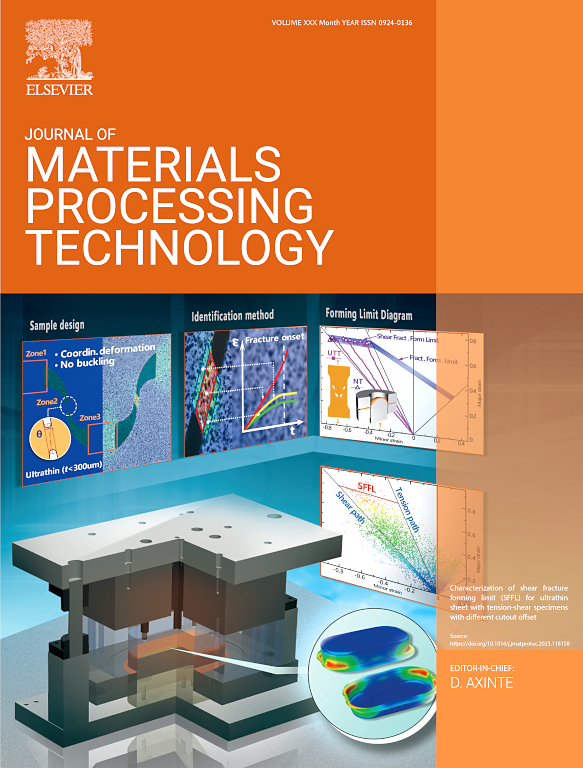利用非均相纳米颗粒优化增材制造无ni高n双相不锈钢的强度-延性平衡
IF 6.7
2区 材料科学
Q1 ENGINEERING, INDUSTRIAL
Journal of Materials Processing Technology
Pub Date : 2025-06-14
DOI:10.1016/j.jmatprotec.2025.118941
引用次数: 0
摘要
双相不锈钢(DSSs)是各种工业应用中具有成本效益的选择。然而,通过激光粉末床熔合(LPBF)制备的无ni高n DSSs表现出严重的强度-延性权衡。在本研究中,无ni高n DSS复合材料具有很强的强度-塑性协同作用(均匀伸长率(UE): ~ 13.0 %;使用亚微米TiN孕育剂和LPBF技术成功制备了极限拉伸强度(UTS): ~ 1096 MPa,与纯DSSs (UE: ~ 3.9 %;生产:∼1314 MPa)。添加亚微米级的TiN颗粒有利于原位形成球形MnTi2O4和块状核壳纳米颗粒,其核壳为MnTi2O4核和TiN壳。这些纳米颗粒作为铁素体的成核点,细化晶粒。DSS/TiN复合材料中形成较多的奥氏体。在DSS/TiN复合材料中,TiN颗粒的细化强化提高了材料的强度-塑性协同作用,奥氏体含量的增加提高了材料的塑性,原位形成的MnTi2O4和核壳纳米颗粒有助于材料强度和塑性的提高。这些因素促成了lpbf制造的DSS/TiN复合材料具有优异的强度-延性协同作用。本研究通过原位形成MnTi2O4和核壳纳米颗粒,成功地优化了lpbf制备的无ni高n DSSs的力学性能,而无需后处理。这些纳米颗粒的成功创造为通过LPBF技术和原位地层策略生产具有强大强度-延展性协同作用的金属部件奠定了基础。本文章由计算机程序翻译,如有差异,请以英文原文为准。
Optimizing the severe strength-ductility trade-off in additively manufactured Ni-free high-N duplex stainless steels via heterogeneous nanoparticles
Duplex stainless steels (DSSs) are a cost-effective option for various industrial applications. However, Ni-free high-N DSSs fabricated via the laser powder bed fusion (LPBF) exhibits a severe strength-ductility trade-off. In this study, a Ni-free high-N DSS composite with great strength-ductility synergy (uniform elongation (UE): ∼13.0 %; ultimate tensile strength (UTS): ∼1096 MPa) was successfully fabricated using submicron TiN inoculants and the LPBF technique, in comparison to pure DSSs (UE: ∼3.9 %; UTS: ∼1314 MPa). Adding submicron TiN particles facilitated the in-situ formation of spherical MnTi2O4 and block-shaped core-shell nanoparticles with a MnTi2O4 core and a TiN shell. These nanoparticles acted as nucleation sites for ferrite, refining grains. More austenite was formed in DSS/TiN composites. In DSS/TiN composites, the refinement strengthening induced by the addition of TiN particles improved the strength-ductility synergy, the increased austenite content enhanced the ductility, and the in-situ formed MnTi2O4 and core-shell nanoparticles contributed to the improvement of strength and ductility. These factors contributed to an excellent strength-ductility synergy in LPBF-fabricated DSS/TiN composites. This study successfully achieved mechanical property optimization of LPBF-fabricated Ni-free high-N DSSs without post-heat treatment by producing in-situ formed MnTi2O4 and core-shell nanoparticles. The successful creation of these nanoparticles sets the stage for producing metallic components with great strength-ductility synergy via LPBF technique and in-situ formation strategy.
求助全文
通过发布文献求助,成功后即可免费获取论文全文。
去求助
来源期刊

Journal of Materials Processing Technology
工程技术-材料科学:综合
CiteScore
12.60
自引率
4.80%
发文量
403
审稿时长
29 days
期刊介绍:
The Journal of Materials Processing Technology covers the processing techniques used in manufacturing components from metals and other materials. The journal aims to publish full research papers of original, significant and rigorous work and so to contribute to increased production efficiency and improved component performance.
Areas of interest to the journal include:
• Casting, forming and machining
• Additive processing and joining technologies
• The evolution of material properties under the specific conditions met in manufacturing processes
• Surface engineering when it relates specifically to a manufacturing process
• Design and behavior of equipment and tools.
 求助内容:
求助内容: 应助结果提醒方式:
应助结果提醒方式:


